Power electronic handbook
Подождите немного. Документ загружается.

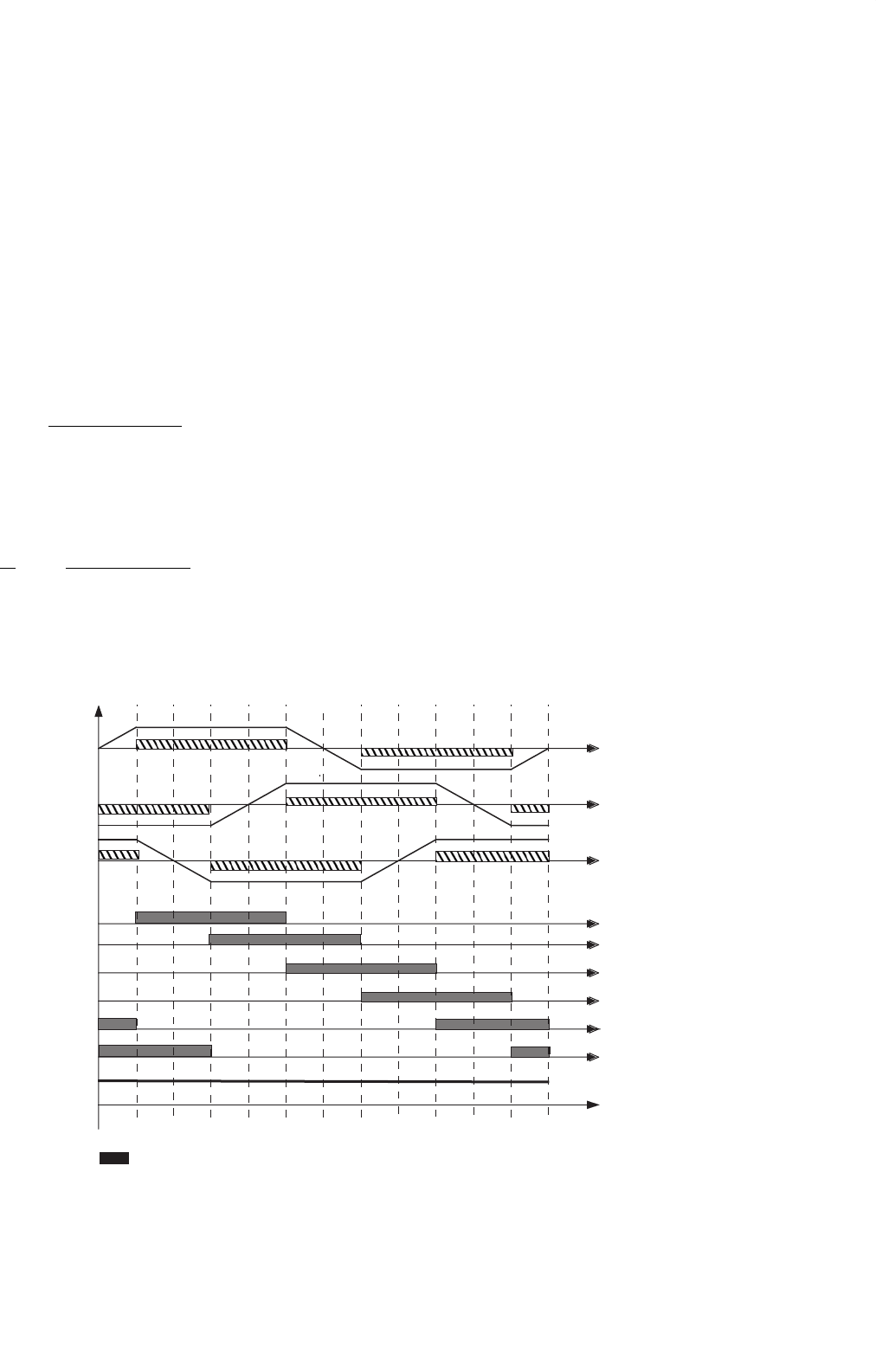
1038 H. A. Toliyat et al.
voltage equation of the BLDC motor can be written as
v
a
v
b
v
c
=
R +pL
s
00
0 R +pL
s
0
00R +pL
s
·
i
a
i
b
i
c
+
e
a
e
b
e
c
(37.2)
where v
a
, v
b
, v
c
are the phase voltages, i
a
, i
b
, i
c
are the phase
currents, e
a
, e
b
, e
c
are the phase back-EMF voltages, R is the
phase resistance, L
s
is the synchronous inductance per phase
and includes both leakage and armature reaction inductances,
and p represents d/dt . The electromagnetic torque is given by
T
e
=
(
e
a
i
a
+e
b
i
b
+e
c
i
c
)
ω
m
(37.3)
where ω
m
is the mechanical speed of the rotor. The equation
of motion is
d
dt
ω
m
=
(
T
e
−T
L
−Bω
m
)
J
(37.4)
where T
L
is the load torque, B is the damping constant, and J
is the moment of inertia of the rotor shaft and the load.
E
b
E
c
I
a
I
b
I
c
T
1
T
2
T
3
T
4
T
5
T
6
30 600 120 15090 210 240180 300 330270 360
E
a
Torque
Switches (T1-T6) turn on
Rotor position (Deg.)
FIGURE 37.9 The principle of the six-step current control algorithm. T
1
–T
6
are the gate signals, E
a
, E
b
, and E
c
are the motor phase back-EMF, I
a
,
I
b
, and I
c
are the motor phase currents.
37.4.2 Torque Generation
From Eq. (37.3), the electromagnetic torque of the BLDC
motor is related to the product of the phase back-EMF and
current. The back-EMFs in each phase are trapezoidal in shape
and are displaced by 120 electrical degrees with respect to each
other in a three-phase machine. A rectangular current pulse
is injected into each phase so that current coincides with the
crest of the back-EMF waveform; hence the motor develops
an almost constant torque. This strategy, commonly called six-
step current control is shown Fig. 37.9. The amplitude of each
phase’s back-EMF is proportional to the rotor speed, and is
given by
E = kφω
m
(37.5)
where k is a constant and depends on the number of turns
in each phase, φ is the permanent magnet flux, and ω
m
is
the mechanical speed. In Fig. 37.9, during any 120
◦
interval,
the instantaneous power converted from electrical to mechan-
ical, P
o
, is the sum of the contributions from two phases in
series, and is given by
P
o
= ω
m
T
e
= 2EI (37.6)
where T
e
is the output torque and I is the amplitude of the
phase current. From Eqs. (37.4) and (37.6), the expression for
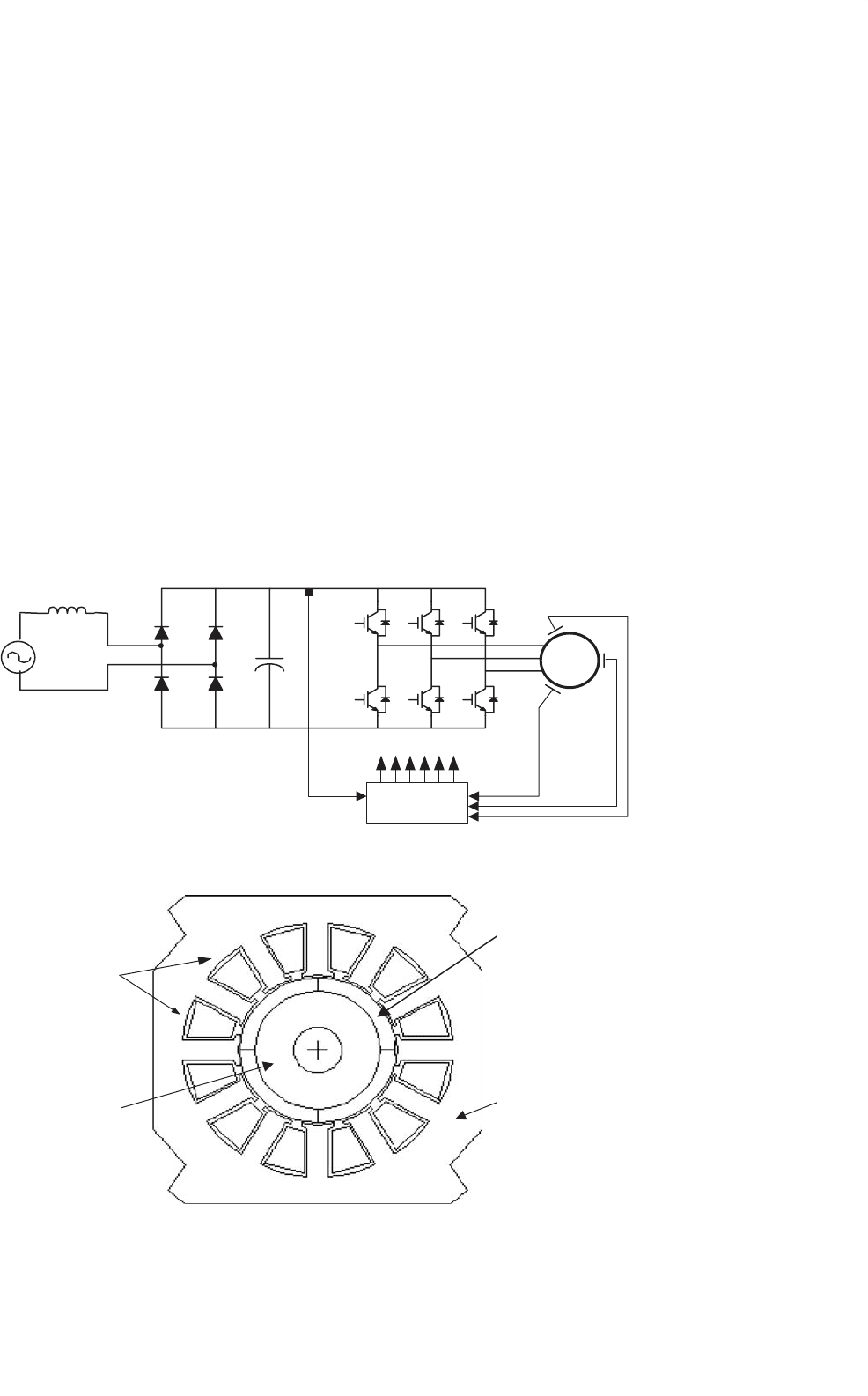
37 DSP-based Control of Variable Speed Drives 1039
output torque can be written as
T
e
= 2kφI = k
t
I (37.7)
where K
t
is the torque constant. Since the electromagnetic
torque is only proportional to the amplitude of the phase
current in Eq. (37.7), torque control of the BLDC motor is
essentially accomplished by phase current control.
37.4.3 BLDC Motor Control Topology
Based on the previously discussed concept, a BLDC motor-
drive system is shown in Fig. 37.10. It can be seen that the total
drive system consists of the BLDC motor, power electronics
converter, sensor, and controller.
The BLDC motors are predominantly surface-magnet
machines with wide magnet pole arcs. The stator windings
are usually concentrated windings, which produce a square
waveform distribution of flux density around the air-gap. The
design of the BLDC motor is based on the crest of each half-
cycle of the back-EMF waveform. In order to obtain a smooth
D
1
D
2
D
4
D
3
C
T
1
T
4
T
3
T
6
T
5
T
2
L
d
V
s
BLDC
Hall sensors
controller
DC-Bus
current
Gates T1 to T6
FIGURE 37.10 BLDC motor control system.
Permanent
Magnet
Stator
Windings
Rotor
A+
A+
B+
B+
C+
C+
C−
C−
A−
A−
B−
B−
FIGURE 37.11 The 4-pole 12-slot BLDC motor.
output torque, the back-EMF waveform should be wider than
120
◦
electrical degrees. A typical BLDC motor with 12 stator
slots and 4 poles on the rotor is shown in Fig. 37.11. The
inverter is usually responsible for the electronic commutation
and current regulation. For the six-step current control, if the
motor windings are Y-connected without the neutral connec-
tion, only two of the three phase currents flow through the
inverter in series. This results in the amplitude of the DC link
current always being equal to that of the phase currents. The
PWM current controllers are typically used to regulate the
actual machine currents in order to match the rectangular
current reference waveforms shown in Fig. 37.9. For example,
during one 60
◦
interval, when switches T
1
and T
6
are active,
phases A and B conduct. The lower switch T
6
is always turned
on and the upper switch T
1
is chopped on/off using either a
hysteresis current controller with variable switch frequency or
a PI controller with fixed switch frequency.
When T
1
and T
6
are conducting, current builds up in the
path as shown in Fig. 37.12a with dashed line. When switch T
1
is turned off, the current decays through diode D
4
and switch
T
6
as depicted in Fig. 37.12b. In the next interval, switch T
2
is
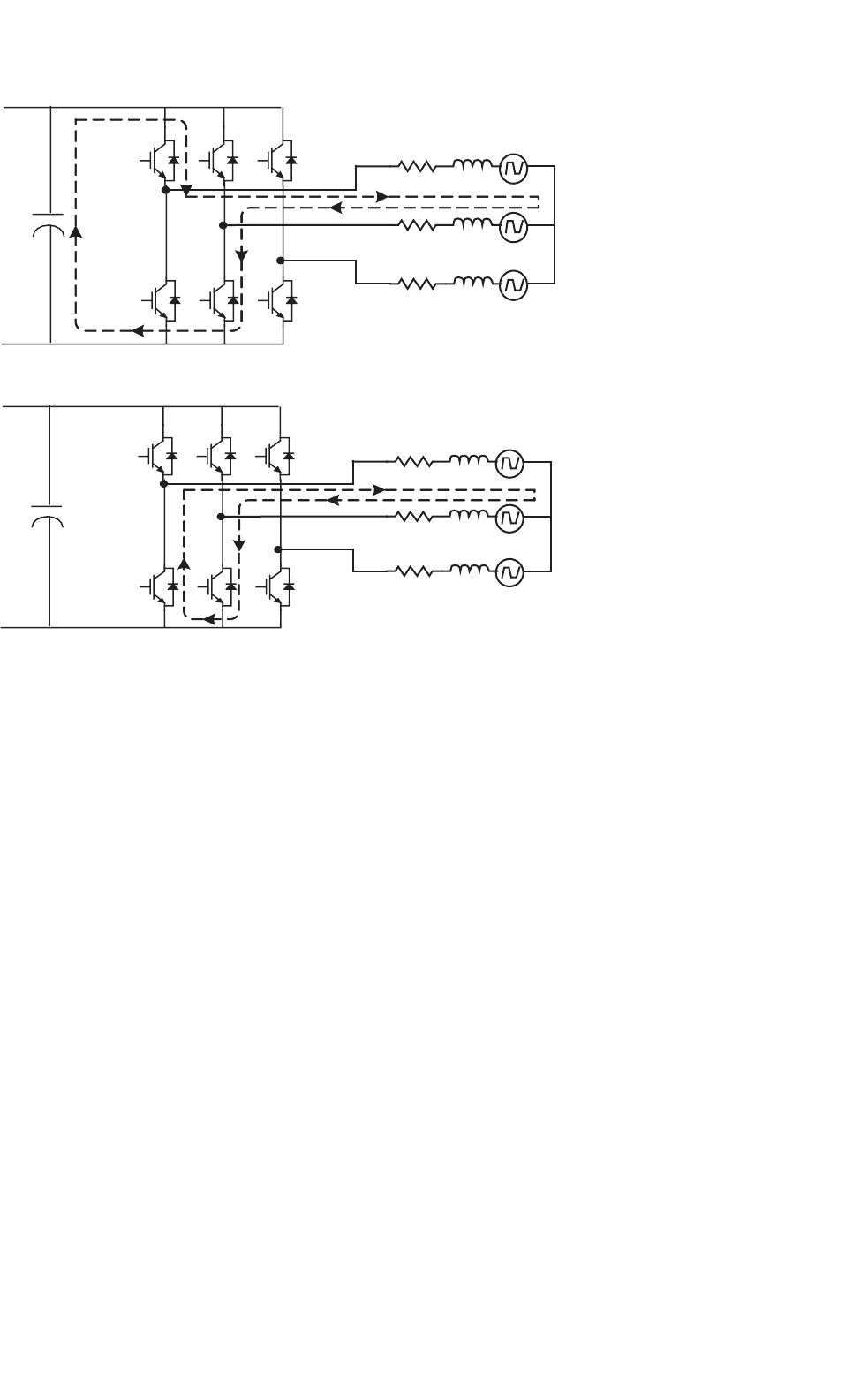
1040 H. A. Toliyat et al.
C
T
6
T
2
r
a
L
c
E
a
r
b
L
c
E
b
r
c
L
c
E
c
T
1
T
3
T
5
T
4
D
1
D
3
D
5
D
2
D
6
D
4
C
T
4
T
6
T
2
r
a
L
c
E
a
r
b
L
c
E
b
r
c
L
c
E
c
T
3
T
5
T
1
D
1
D
3
D
5
D
2
D
6
D
4
(a)
(b)
FIGURE 37.12 The current path when the switch T
1
turns on and turns off.
on, and T
1
is chopped so that phase A and phase C conduct.
During the commutation interval, the phase B current rapidly
decreases through the freewheeling diode D
3
until it becomes
zero and the phase C current builds up.
From the above analysis, each of the upper switches is
always chopped for one 120
◦
interval and the corresponding
lower switch is always turned on per interval. The freewheeling
diodes provide the necessary paths for the currents to circulate
when the switches are turned off and during the commuta-
tion intervals. There are two types of sensors for the BLDC
drive system: a current sensor and a position sensor. Since the
amplitude of the dc link current is always equal to the motor
phase current in six-step current control, the dc link current is
measured instead of the phase current. Thus, a shunt resistor,
which is in series with the inverter, is usually used as the cur-
rent sensor. Hall-effect position sensors typically provide the
position information needed to synchronize the stator excita-
tion with rotor position in order to produce constant torque.
Hall-effect sensors detect the change in magnetic field. The
rotor magnets are used as triggers for the Hall sensors. A sig-
nal conditioning circuit is needed for noise cancellation in
Hall-effect sensors circuits. In six-step current control algo-
rithm, rotor position needs to be detected at only six discrete
points in each electrical cycle. The controller tracks these six
points so that the proper switches are turned on or off for the
correct intervals. Three Hall-effect sensors, spaced 120 elec-
trical degrees apart, are mounted on the stator frame. The
digital signals from the Hall sensors are then used to determine
the rotor position and switch gating signals for the inverter
switches.
37.4.4 DSP Controller Requirements
The controller of BLDC drive systems reads the current and
position feedback, implements the speed or torque control
algorithm, and finally generates the gate signals. The con-
nectivity of the LF2407 in this application is illustrated in
Fig. 37.13. Three capture units in the LF2407 are used to detect
both the rising and falling edges of Hall-effect signals. Hence,
every 60 electrical degrees of motor rotation, one capture unit
interrupt is generated which ultimately causes a change in the
gating signals and the motor to move to the next position. One
input channel of the 10-bit A/D converter reads the dc link
current. The output pins PWM1–PWM6 are used to supply
the gating signals to the inverter.
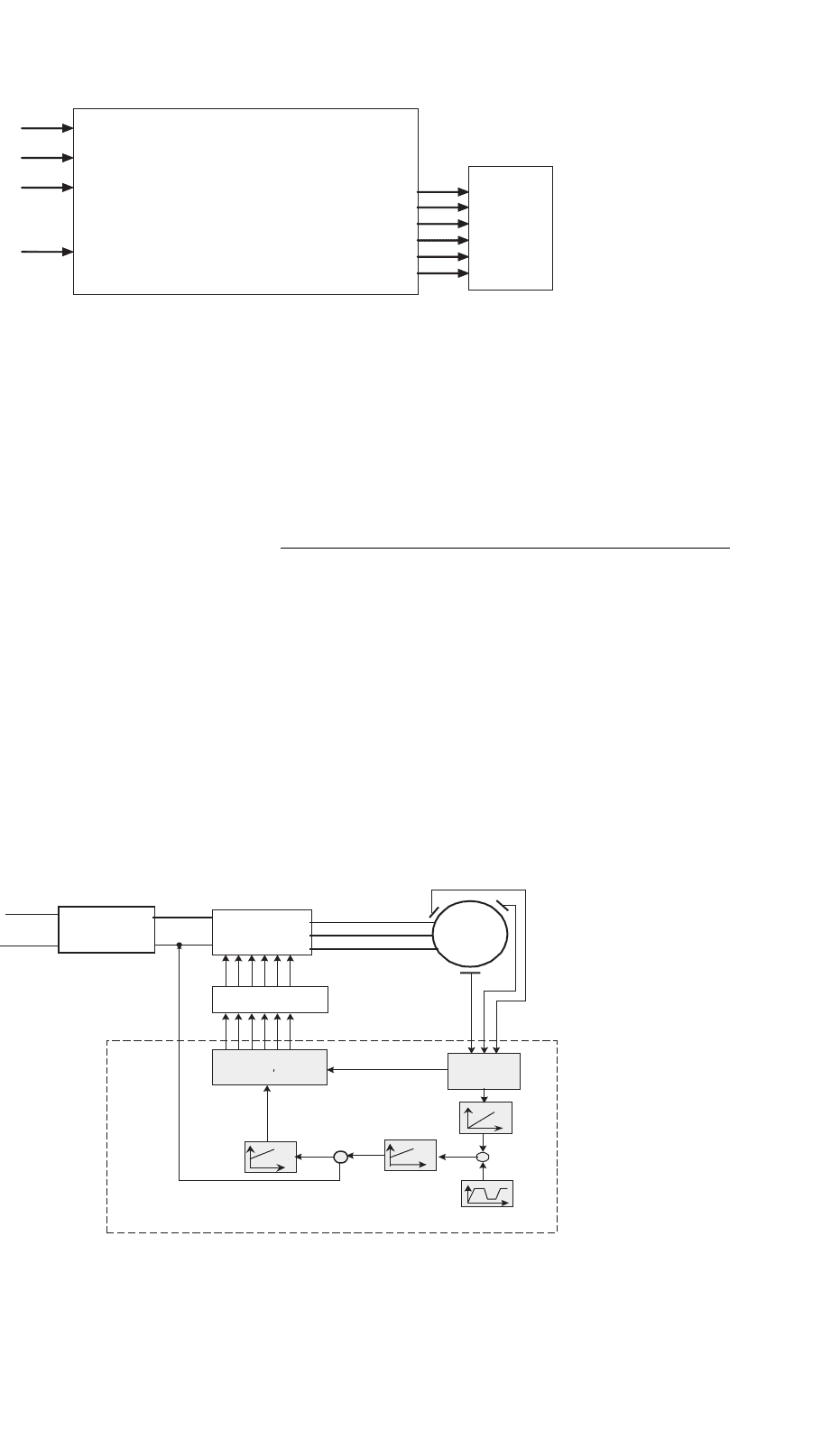
37 DSP-based Control of Variable Speed Drives 1041
TMS320F2407
PWM-1 &
PWM-6
ADCIN0I
dc
Capture-1
Capture-2
H1
H2
Capture-2H2
Gate
Drive
FIGURE 37.13 The interface of LF2407.
37.4.5 Implementation of the BLDC Motor
Control Algorithm Using LF2407
A block diagram of the BLDC motor control system is shown
in Fig. 37.14. The dashed line separates the software from the
hardware components introduced in the previous section. It is
necessary to choose hardware components carefully in order
to ensure high processing speed and precision in the overall
control system. The overall control algorithm of the BLDC
motor consists of nine modules:
• Initialization procedure
• Detection of Hall-effect signals
• Speed control subroutine
• Measurement of current
• Speed profiling
•
Calculation of actual speed
• PID regulation
• PWM generation
•
DAC output
BLDC
Firing
Circuit
Rectifier
Voltage
Source
~120 V
Integrator
Current PI
Controller
Speed PI
Controller
PWM
Generator
Hall
Signal
Hall_drv
Hall_state
ωf
b
−
+
LF2407
I
re
f
I
f
b
−
+
Speed Profile
ω
re
f
FIGURE 37.14 The block diagram of BLDC motor control algorithm.
The flowchart of the overall control algorithm is illustrated
in Fig. 37.15.
37.5 DSP-based Control of Permanent
Magnet Synchronous Machines
As previously described, the permanent magnet synchronous
motor (PMSM) is a PM motor with a sinusoidal back-EMF.
Compared to the BLDC motor, it has less torque ripple because
the torque pulsations associated with current commutation do
not exist. A carefully designed machine in combination with
a good control technique can yield a very low level of torque
ripple (<2% rated), which is attractive for high-performance
motor control applications such as machine tool and servo
applications.
In this section, following the same procedures used in the
previous section, the principles of the PMSM drive system will
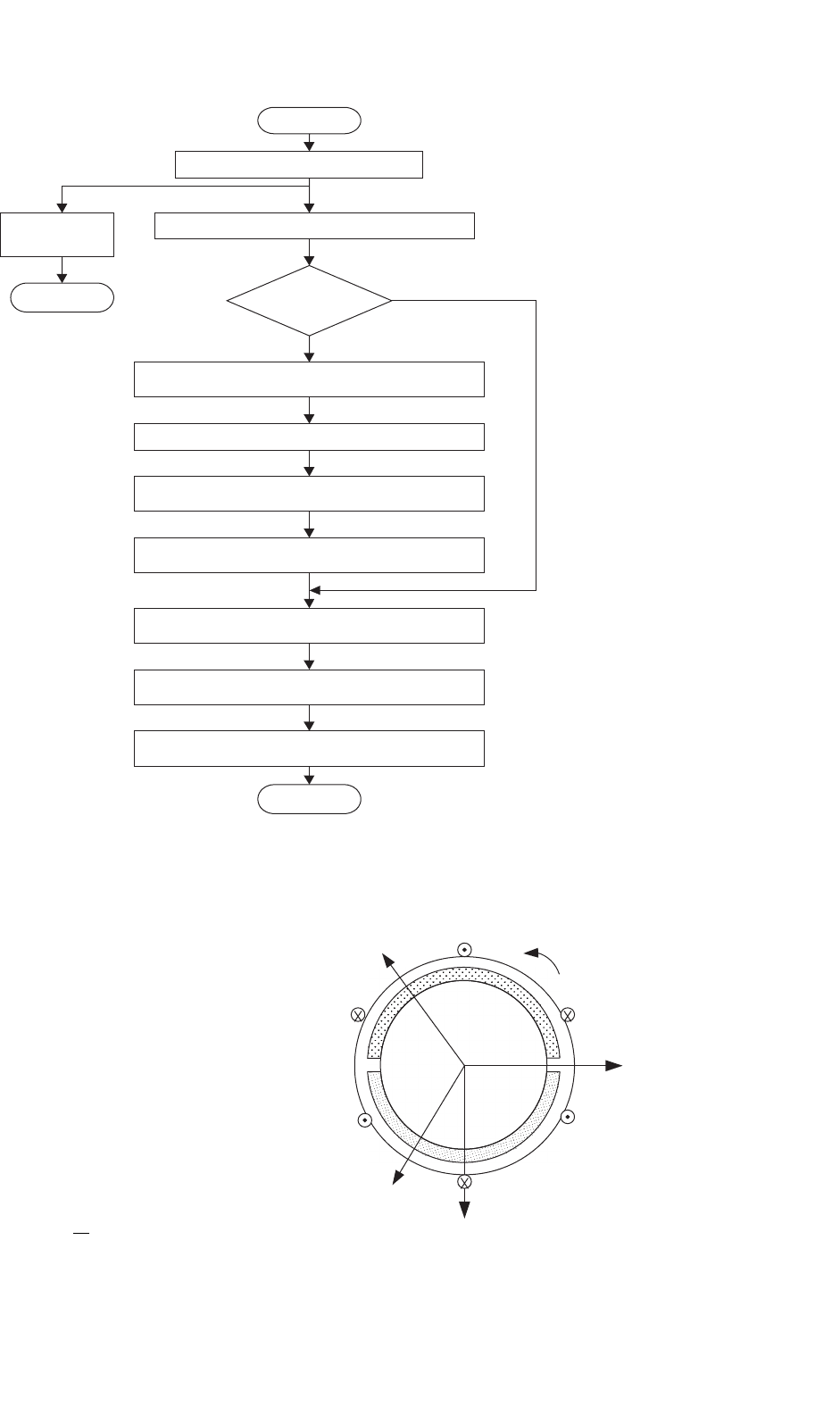
1042 H. A. Toliyat et al.
Read DC link current I
dc
; Load Hall Effect signals
Start
Initialization procedure
Execute
speed loop?
Read reference speed w
ref
Read Hall
sensor signal
End
No
Yes
Calculate the motor actual speed w
r
Speed PI regulator
Calculate the commended torque
Current PI regulator
Generate the PWM using ∆ generator
End
Output the program variables to DAC0~DAC3
Calculate the command DC link current i
dc
using (28.7)
*
FIGURE 37.15 BLDC algorithm flowchart.
be introduced. Later, the control implementation using the
LF2407 DSP will be described in detail.
37.5.1 Mathematical Model of PMSM
Figure 37.16 depicts the simplified three-phase surface
mounted PMSM motor for our discussion. The stator wind-
ings, as–as
, bs–bs
, and cs–cs
, are shown as lumped windings
for simplicity, but are actually distributed around the stator.
The rotor has 2 poles. Mechanical rotor speed and position are
denoted as ω
rm
and θ
rm
, respectively. Electrical rotor speed and
position, ω
r
and θ
r
, are defined as P/2 times the corresponding
mechanical quantities, where P is the number of poles.
Based on the above motor definition, the voltage equation
in the abc stationary reference frame is given by
V
abcs
= R
s
i
abcs
+
d
dt
λ
abcs
(37.8)
as
as'
bs
cs
bs'
cs'
A-axis
B-axis
C-axis
Wrm
N
S
d-axis
q-axis
FIGURE 37.16 The cross section of PMSM.

37 DSP-based Control of Variable Speed Drives 1043
where
f
abcs
=
f
as
f
bs
f
cs
T
(37.9)
and the stator resistance matrix is given by
R
s
= diag[
r
s
r
s
r
s
]
(37.10)
The flux linkages equation can be expressed by
λ
abcs
= L
s
i
abcs
+λ
m
sin ϑ
r
sin(ϑ
r
−
2π
3
)
sin(ϑ
r
−
4π
3
)
(37.11)
where λ
m
denotes the amplitude of the flux linkages estab-
lished by the permanent magnet as viewed from the stator
phase windings. Note that in Eq. (37.11) the back-EMFs are
sinusoidal waveforms that are 120
◦
apart from each other.
The stator self-inductance matrix, L
s
, is given as
L
s
=
L
ls
+L
A
−L
B
cos 2θ
r
−
1
2
L
A
−L
B
cos 2(θ
r
−π/3) −
1
2
L
A
−L
B
cos 2(θ
r
+π/3)
−
1
2
L
A
−L
B
cos 2(θ
r
−π/3) L
ls
+L
A
−L
B
cos 2(θ
r
−2π/3) −
1
2
L
A
−L
B
cos 2(θ
r
+π)
−
1
2
L
A
−L
B
cos 2(θ
r
+π/3) −
1
2
L
A
−L
B
cos 2(θ
r
+π) L
ls
+L
A
−L
B
cos 2(θ
r
+2π/3)
(37.12)
The torque and speed are related by the electromechanical
motion equation
J
d
dt
ω
rm
=
P
2
(T
e
−T
L
) −B
m
ω
rm
(37.15)
where J is the rotational inertia, B
m
is the approximated
mechanical damping due to friction, and T
L
is the load torque.
37.5.2 Mathematical Model of PMSM in Rotor
Reference Frame
The voltage and torque equations can be expressed in the rotor
reference frame in order to transform the time-varying vari-
ables into steady-state constants. The transformation of the
three-phase variables in the stationary reference frame to the
rotor reference frame is defined as
f
qd0r
= K
r
f
abcs
(37.16)
where
k
r
=
2
3
cos θ
r
cos(θ
r
−
2π
3
) cos(θ
r
+
2π
3
)
sin θ
r
sin(θ
r
−
2π
3
) sin(θ
r
+
2π
3
)
1
2
1
2
1
2
If the applied stator voltages are given by
V
as
=
√
2V
s
cos θ
ev
V
bs
=
√
2V
s
cos(θ
ev
−
2π
3
)
V
cs
=
√
2V
s
cos(θ
ev
+
2π
3
)
(37.17)
Then applying (37.16) to (37.8), (37.11), and (37.17) yields
v
r
qs
= r
s
i
r
qs
+ω
r
λ
r
ds
+
d
dt
λ
r
qs
(37.18)
v
r
ds
= r
s
i
r
ds
−ω
r
λ
r
qs
+
d
dt
λ
r
ds
(37.19)
λ
r
qs
= L
qs
i
r
qs
(37.20)
λ
r
ds
= L
ds
i
r
ds
+λ
r
m
(37.21)
where the q- and d-axes self-inductances are given by
L
qs
= L
ls
+L
mq
and L
ds
= L
ls
+L
md
, respectively.
The electromagnetic torque can be written as
T
e
=
3
2
P
2
[λ
r
m
i
r
qs
+(L
ds
−L
qs
)i
qs
i
ds
] (37.22)
The electromagnetic torque may be written as
T
e
=
P
2
λ
m
(i
as
−
1
2
i
bs
−
1
2
i
cs
)cosθ
r
−
√
3
2
(i
bs
−i
cs
)sinϑ
r
+
L
md
−L
mq
3
(i
2
as
−
1
2
i
2
bs
−
1
2
i
2
cs
−i
as
i
bs
−i
as
i
cs
+2i
bs
i
cs
)
sin2θ
r
+
√
3
2
i
2
bs
i
2
cs
−2i
as
i
bs
+2i
as
i
cs
cos2θ
r
+T
cog
(θ
r
)
(37.13)
In Eq. (37.13), T
cog
(θ
r
) represents the cogging torque and
the d- and q-axes magnetizing inductances are defined by
L
md
=
3
2
(L
A
−L
B
)
and
L
md
=
3
2
(L
A
+L
B
) (37.14)
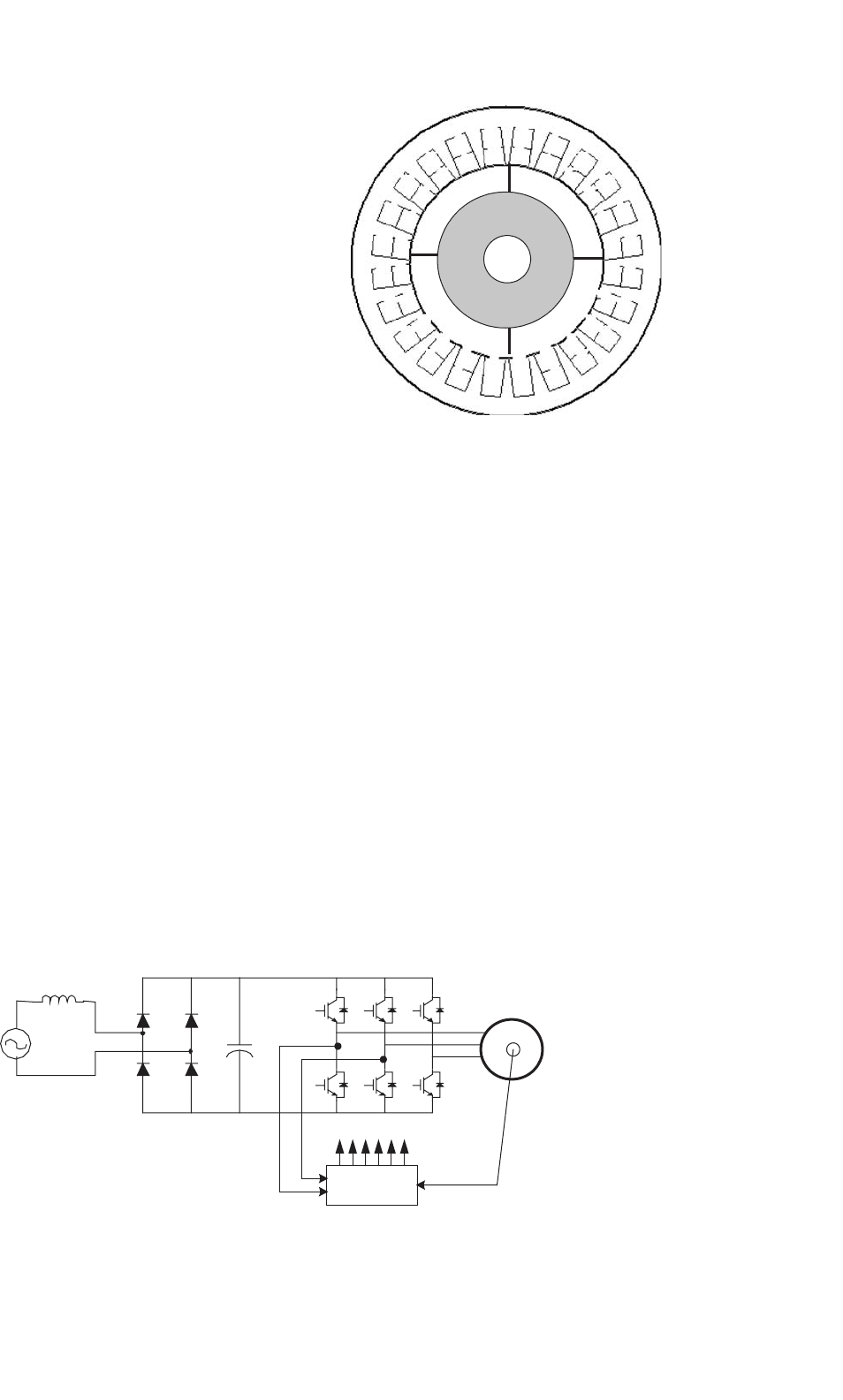
1044 H. A. Toliyat et al.
From Eq. (37.22), it can be seen that torque is related only
to the d- and q-axes currents. Since L
q
≥ L
d
(for surface
mount PMSM both inductances are equal), the second item
contributes a negative torque if the flux weakening control has
been used. In order to achieve the maximum torque/current
ratio, the d-axis current is set to zero during the constant
torque control so that the torque is proportional only to the
q-axis current. Hence, this results in the control of the q-axis
current for regulating the torque in rotor reference frame.
37.5.3 PMSM Control Topology
Based on the above analysis, a PMSM drive system is developed
as shown in Fig. 37.17. The total drive system looks similar to
that of the BLDC motor and consists of a PMSM, power elec-
tronics converter, sensors, and controller. These components
are discussed in detail in the following sections.
The design consideration of the PMSM is to first generate
the sinusoidal back-EMF. Unlike the BLDC, which needs con-
centrated windings to produce the trapezoidal back-EMF, the
stator windings of PMSM are distributed in as many slots per
pole as deemed practical to approximate a sinusoidal distri-
bution. To reduce the torque ripple, standard techniques such
as skewing and chorded windings are applied to the PMSM.
With the sinusoidally excited stator, the rotor design of the
PMSM becomes more flexible than the BLDC motor where the
surface-mount permanent magnet is a favorite choice. Besides
the common surface-mount non-salient pole PM rotor, the
salient pole rotor, like inset and buried magnet rotors, are
often used because they offer appealing performance charac-
teristics during the flux weakening region. A typical PMSM
with 36 stator slots in stator and 4 poles on the rotor is shown
in Fig. 37.18.
Due to the sinusoidal nature of the PMSM, control algo-
rithms such as V/f and vector control, developed for other AC
motors, can be directly applied to the PMSM control system. If
the motor windings are Y-connected without a neutral connec-
tion, three-phase currents can flow through the inverter at any
D
1
D
4
D
3
C
T
1
T
2
T
3
T
4
T
5
T
6
L
d
Vs
Controller
to T1~T6
PMSM
ias
ibs
Resolver
D
2
q
FIGURE 37.17 The PMSM speed control system.
N
N
S
S
A
A
A
A
−C
−C
−C
−C
−A
−A
−A
−A
−A
−A
−A
−A
−B
−B
−B
−B
−C
−C
−C
−C
−B
−B
−B
−B
C
C
B
B
B
B
C
C
C
C
C
C
B
B
B
B
A
A
A
A
FIGURE 37.18 A 4-pole 24-slot PMSM.
moment. With respect to the inverter switches, three switches,
one upper and two lower in three different legs conduct at any
moment as shown in Fig. 37.19. The PWM current control is
still used to regulate the actual machine current. Either a hys-
teresis current controller, a PI controller with sine-triangle, or
an SVPWM strategy is employed for this purpose. Unlike the
BLDC motor, the three switches are switched at any time.
37.5.4 DSP Controller Requirements
The LF2407 is used as the controller to implement speed con-
trol of the PMSM system. The interface of the LF2407 is
illustrated in Fig. 37.20. Similar to the BLDC motor control
system, three input channels are selected to read the two-
phase currents and resolver signal. Because a resolver is used
in one case, the quadrature-encoder-pulse (QEP) inputs are
not used. The QEP inputs work only with a QEP signal that a
rotary encoder supplies. The DSP output pins PWM1–PWM6
used to supply the gating signals to the switches and form the
output of the control part of the system.
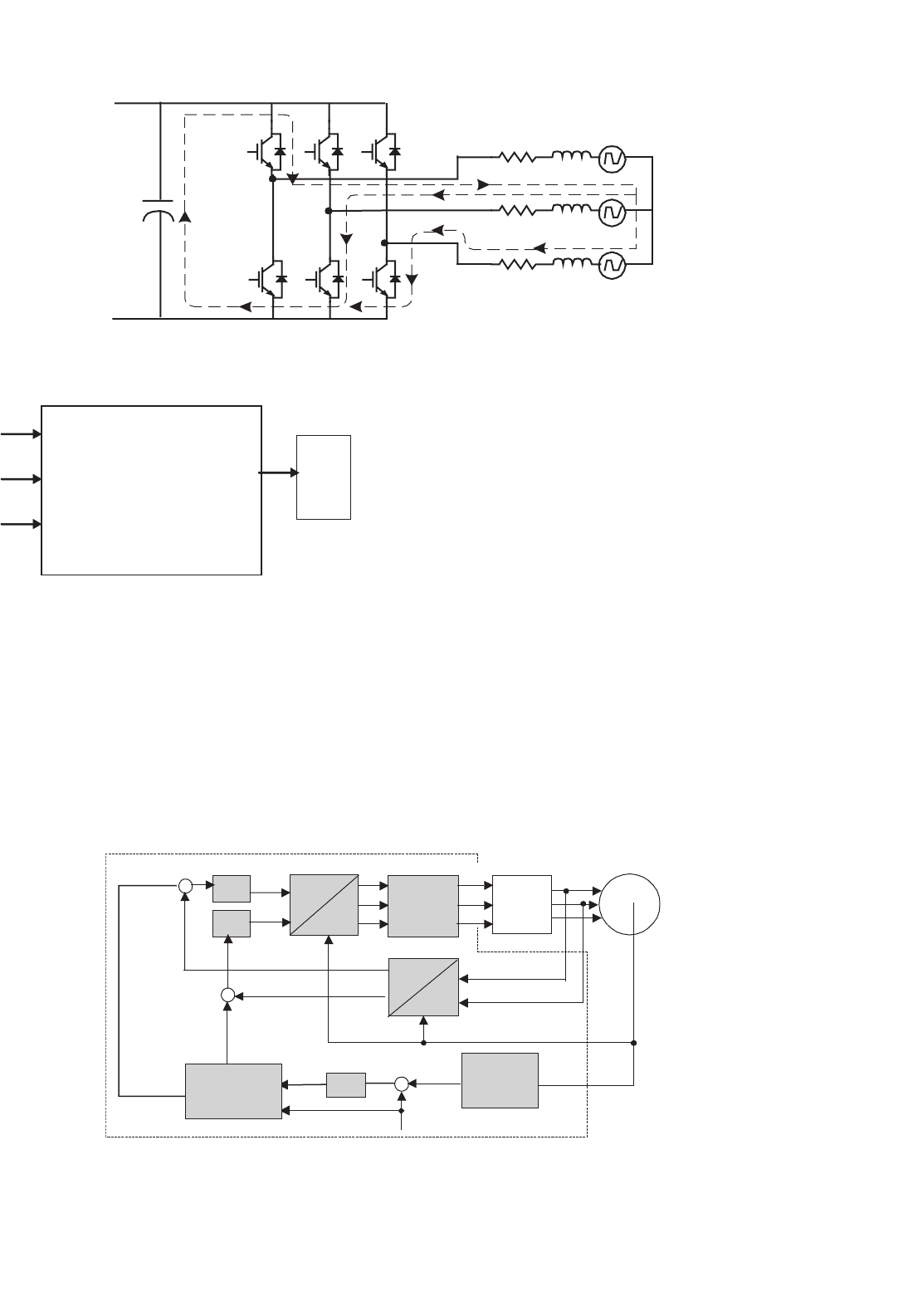
37 DSP-based Control of Variable Speed Drives 1045
C
T
2
T
4
T
6
r
a
L
c
E
a
r
b
L
c
E
b
r
c
L
c
E
c
T
1
T
3
T
5
FIGURE 37.19 The current path when the three phases are chopped.
Gate
Drive
PWM-1 to
PWM-6
TMS320LF2407
ADCIN0
ADCIN1
ia
ib
ADCIN2
q
FIGURE 37.20 The interface of LF2407.
37.5.5 Implementation of the PMSM Algorithm
Using the LF2407
The block diagram of the PMSM drive system is displayed in
Fig. 37.21.
The flowchart of the developed software is shown in
Fig. 37.22. The control program of the PMSM has one main
Software
+
w
ref
−
−
−
−
T
ec
Vbs
s
Vcs
Sc
Sb
w
r
Sa
Vas
v
qsr
v
dsr
i
qsr
i
dsr
ibs
ias
+
PWM
Inverter
d, q
a, b ,c
PWM
Generator
PI
PI
d, q
a b,c
PM
SM
+
PI
= 0
*
i
dsr
*
i
qsr
−
Speed
calculator
Current
calculator
*
q
FIGURE 37.21 Block diagram of PMSM speed control system.
routine and includes four modules:
•
Initialization procedure
• DAC module
• ADC module
• Speed control module
In the following section speed control module is disscussed.
37.5.5.1 The Speed Control Algorithm
The requirement for speed control algorithm can be item-
ized as:
• Reading the current and position signal, then generating
the commanded speed profile
• Calculating the actual motor speed, transferring the
variables in the abc model to the d–q model and reverse
• Regulating the motor speed and currents using the
vector-control strategy
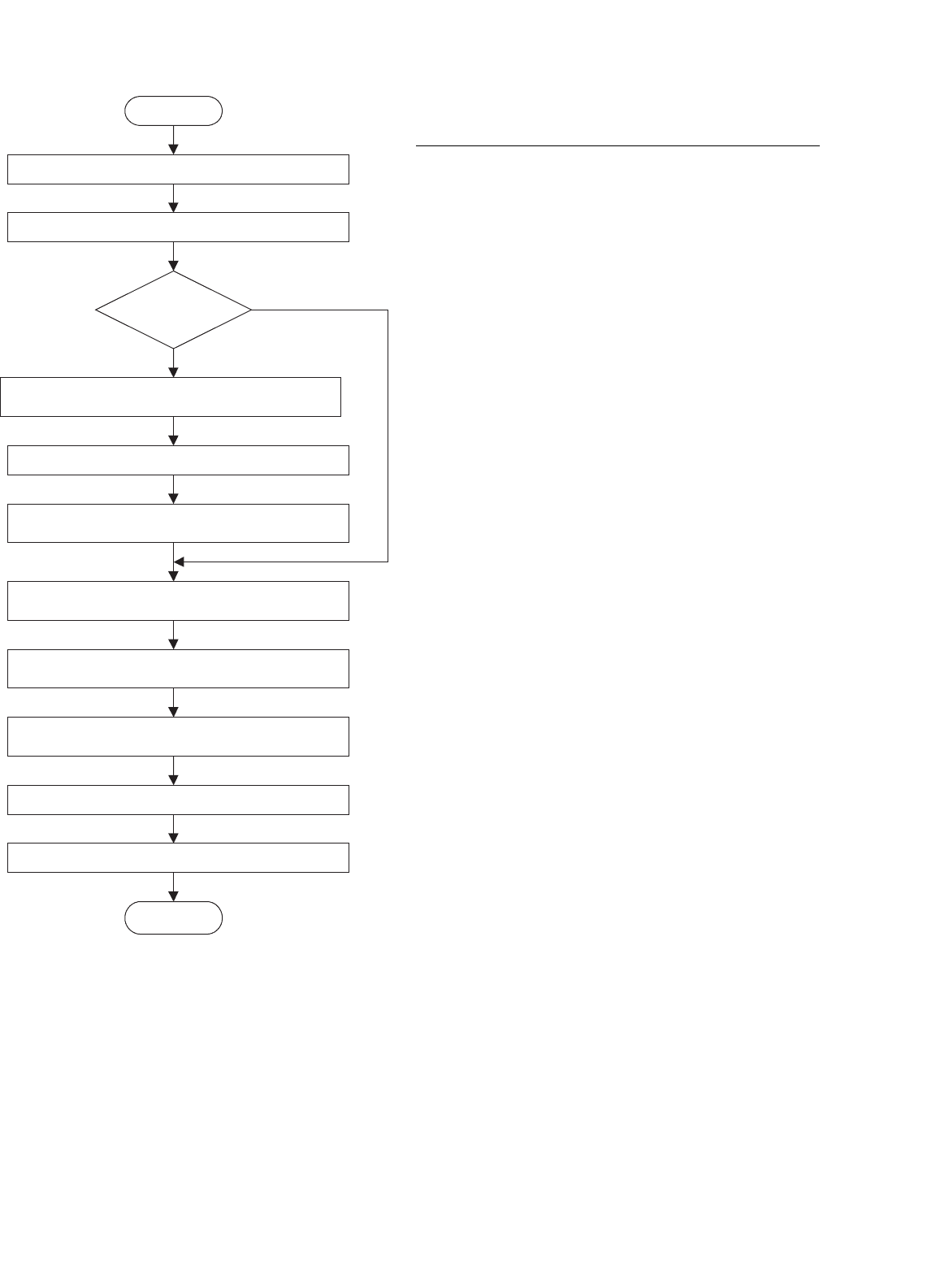
1046 H. A. Toliyat et al.
No
Yes
Start
Initialization procedure
Read phase current i
a
,i
b
; read the position signal;
Execute
speed loop?
Set reference speed w
ref
and calculate the actual speed
Speed PI regulator used to calculate the commend torque
Calculate the command q-axis current i
qs
; Set i
ds
=
0
Current PI regulator used to calculate the v
ds
,v
qs
in RRF
Transfer i
a
,i
b
to i
ds
,i
qs
in Rotor Reference Frame (RRF)
Transfer v
ds
,v
qs
in RRF to v
a
,v
b
,v
c
Generate the PWM using sine-
D
generator
End
Output the program variables to DAC0~DAC3
**
FIGURE 37.22 The flowchart of PMSM control system.
•
Generating the PWM signal based on the calculated
motor phase voltages
The PWM frequency is determined by the time interval
of the interrupt, with the controlled phase voltages being
recalculated every interrupt.
37.6 DSP-based Vector Control of
Induction Motors
For many years, induction motors have been preferred for
a variety of industrial applications because of their robust
and rugged construction. Compared to dc motors, induction
motors are not as easy to control. They typically draw large
starting currents, about six to eight times their full load values,
and operate with lagging power factor when loaded. However,
with the advent of the vector-control concept for motor con-
trol, it is possible to decouple the torque and the flux, thus
making the control of the induction motor very similar to that
of the dc motor.
The most popular type of induction motor used is the squir-
rel cage induction motor. The rotor consists of a laminated
core with parallel slots for carrying the rotor conductors, which
are usually heavy bars of copper, aluminum, or alloys. One bar
is placed in each slot; or rather, the bars are inserted from the
end when the semi-closed slots are used. The rotor bars are
brazed, electrically welded, or bolted to two heavy and stout
short-circuiting end-rings, thus completing the squirrel cage
construction. The rotor bars are permanently short-circuited
on themselves. The rotor slots are usually not parallel to the
shaft, but are given a slight angle, called a skew, which increases
the rotor resistance due to increased length of rotor bars and an
increase in the slip for a given torque. The skew is also advan-
tageous because it reduces the magnetic hum while the motor
is operating and reduces the locking tendency, or cogging, of
the rotor teeth.
When the three-phase stator windings are fed by a three-
phase supply, a magnetic flux of a constant magnitude rotating
at synchronous speed is created in the air-gap. Due to the
relative speed between the rotating flux and the stationary
conductors, an electromagnetic force (EMF) is induced in the
rotor in accordance with Faraday’s laws of electromagnetic
induction. The frequency of the induced EMF is the same as
the supply frequency, and the magnitude is proportional to the
relative velocity between the flux and the conductors. There-
fore, the rotor current develops in the same direction as the
flux and tries to catch up with the rotating flux.
37.6.1 Induction Motor Field-oriented Control
The term “vector” control refers to the control technique that
controls both the amplitude and the phase of ac excitation
voltage. Vector control controls the spatial orientation of the
EMF in the machine. This has led to the coining of the term
FOC, which is used for controllers that maintain a 90
◦
spatial
orientation between the critical field components.
The required 90
◦
of spatial orientation between key field
components can be compared to the dc motor, where the
armature winding magnetic field and the filed winding mag-
netic filed are always in quadrature. The objective is to force

37 DSP-based Control of Variable Speed Drives 1047
the control of the induction machine to be similar to the con-
trol of a dc motor, i.e., torque control. In dc machines, the
field and the armature winding axes are orthogonal to one
another, making the magnetomotive forces (MMFs) estab-
lished orthogonal. If the iron saturation is ignored, then
the orthogonal fields can be considered to be completely
decoupled.
It is important to maintain a constant field flux for proper
torque control. It is also important to maintain an indepen-
dently controlled armature current in order to overcome the
effects of the detuning of resistance of the armature winding,
and leakage inductance. A spatial angle of 90
◦
between the flux
and MMF axes has to be maintained in order to limit inter-
action between the MMF and the flux. If these conditions are
met at every instant of time, the torque will always follow the
current.
With vector control, the mechanically robust induction
motors can be used in high-performance applications where
dc motors were previously used. The key feature of the control
scheme is the orientation of the synchronously rotating q–d–0
frame to the rotor flux vector. The d-axis component is aligned
with the rotor flux vector and regarded as the flux-producing
current component. On the other hand, the q-axis current,
which is perpendicular to the d-axis, is solely responsible for
torque production.
In order to apply a rotor flux field-orientation condition,
the rotor flux linkage is aligned with the d-axis, so the q-axis
rotor flux in excitation reference frame λ
e
qr
will be zero and
the d-axis rotor flux in the excitation reference frame will be
the rotor flux; λ
e
dr
=
ˆ
λ
r
. Therefore we have:
i
e
ds
=
λ
e
dr
L
m
(37.23)
ω
slip
=
r
r
ˆ
λ
r
L
m
L
r
i
e
qs
=
L
m
i
e
qs
τ
r
λ
r
(37.24)
T
e
=
3
2
P
2
L
m
L
r
ˆ
λ
d
i
e
qs
(37.25)
where τ
r
is rotor time constant, L
m
is magnetizing inductance,
L
r
rotor leakage inductance, r
r
rotor resistance, i
e
qs
q-axis stator
current in excitation frame, i
e
ds
d-axis stator current in exci-
tation frame, and ω
slip
angular frequency of slip. We can find
out that in this case i
e
ds
controls the rotor flux linkage and i
e
qs
controls the electromagnetic torque. The reference currents of
the q–d–0 axis (i
e∗
qs
, i
e∗
ds
) are converted to the reference phase
voltages (v
e∗
ds
, v
e∗
qs
) as the commanded voltages for the con-
trol loop. Given the position of the rotor flux and two-phase
currents, this generic algorithm implements the instantaneous
direct torque and flux control by means of coordinate trans-
formations and PI regulators, thereby achieving accurate and
efficient motor control.
It is clear that for implementing vector control we have to
determine the rotor flux position. This usually is performed by
measuring the rotor position and utilizing the slip relation to
compute the angle of the rotor flux relative to the rotor axis.
Equations (37.23) and (37.24) show that we can control
torque and field by i
ds
and i
qs
in the excitation frame. However,
in the implementation of FOC, we need to know i
ds
and i
qs
in the stationary reference frame. So, we have to know the
angular position of the rotor flux to transform i
ds
and i
qs
from
the excitation frame to the stationary frame. By using ω
slip
,
which is shown in Eq. (37.24) and using actual rotor speed,
the rotor flux position is obtained.
t
0
ω
slip
dt +θ
re
(t) = θ
r
(t) (37.26)
Where θ
re
(t) is electrical angular rotor position, and θ
r
(t)
angular rotor flux position.
The Current Model takes i
ds
and i
qs
as inputs as well as the
rotor mechanical speed and gives the rotor flux position as an
output. Figure 37.23 shows the block diagram of the vector-
control strategy in which speed regulation is possible using a
control loop.
As shown in Fig. 37.23, two-phase currents are measured
and fed to the Clarke transformation block. These projection
outputs are indicated as i
s
ds
and i
s
qs
. These two components
of the current provide the inputs to Park’s transformation,
which gives the currents in the qds
e
excitation reference frame.
The i
e
ds
and i
e
qs
components, which are outputs of the Park
transformation block, are compared to their reference val-
ues i
e∗
ds
, the flux reference, and i
e∗
qs
, the torque reference. The
torque command, i
e∗
qs
, comes from the output of the speed
controller. The flux command, i
e∗
ds
, is the output of the flux
controller which indicates the right rotor flux command for
every speed reference. For i
e∗
ds
, we can use the fact that the
magnetizing current is usually between 40 and 60% of the
nominal current. For operating in speeds above the nomi-
nal speed, a field weakening section should be used in the
flux controller section. The current regulator outputs, v
e∗
ds
and v
e∗
qs
, are applied to the inverse Park transformation. The
outputs of this projection are v
s
ds
and v
s
qs
, which are the com-
ponents of the stator voltage vector in the dqs
s
orthogonal
reference frame. They form the inputs of the space-vector
PWM block. The outputs of this block are the signals that
drive the inverter.
Note that both the Park and the inverse Park transforma-
tions require the exact rotor flux position, which is given by
the Current Model block. This block needs the rotor resistance
or rotor time constant as a parameter. Accurate knowledge of
the rotor resistance is essential to achieve the highest possible
efficiency from the control structure. Lack of this knowledge
results in the detuning of the FOC. In Fig. 37.23, a space-
vector PWM has been used to emulate v
s
ds
and v
s
qs
in order to
implement current regulation.
